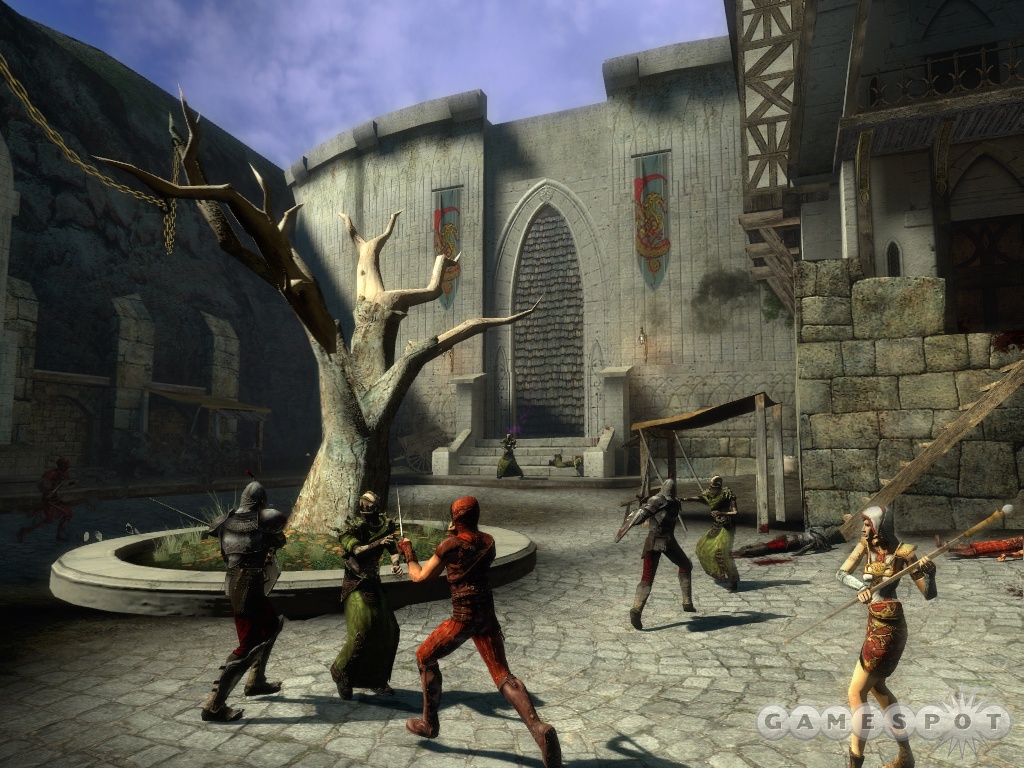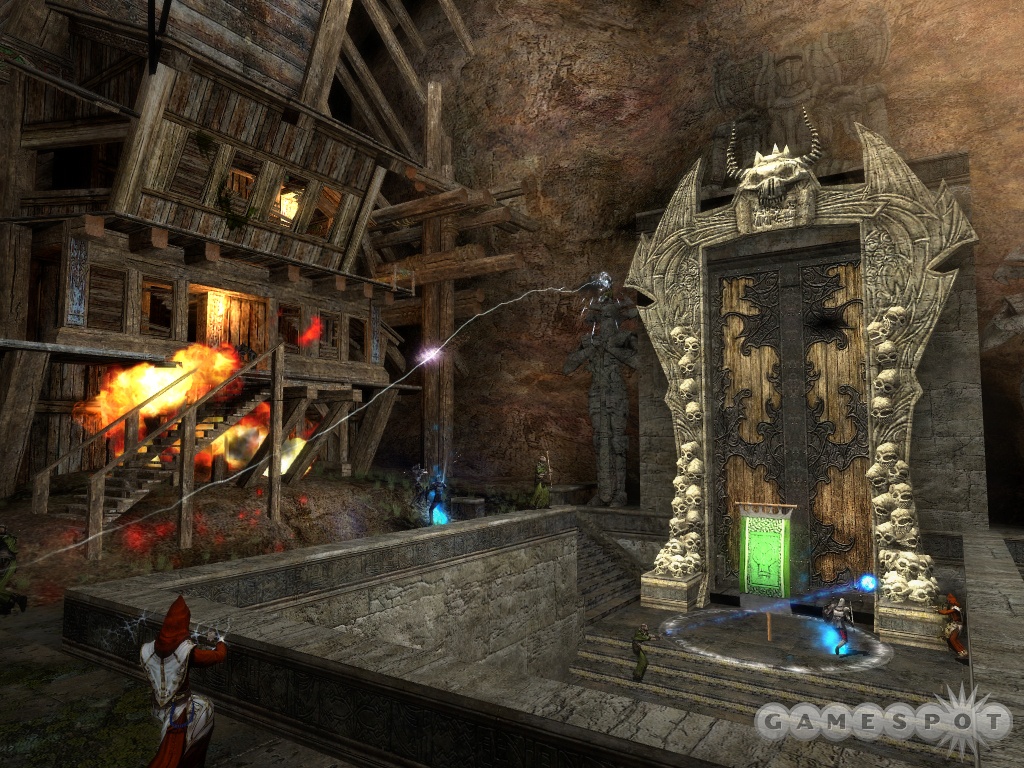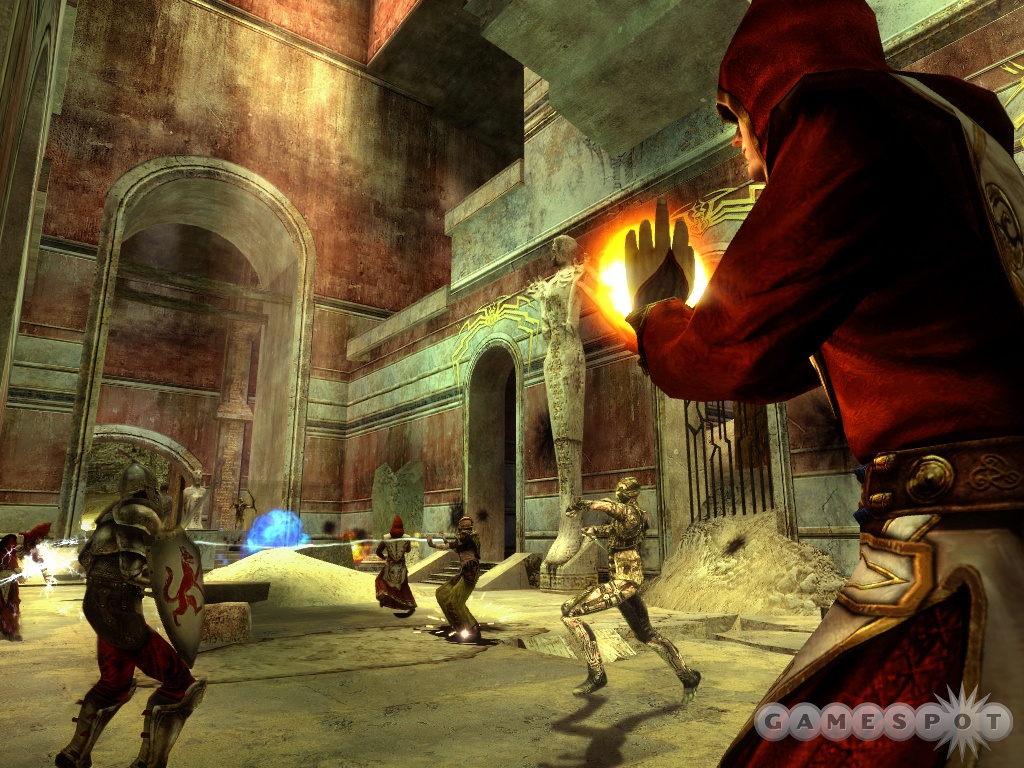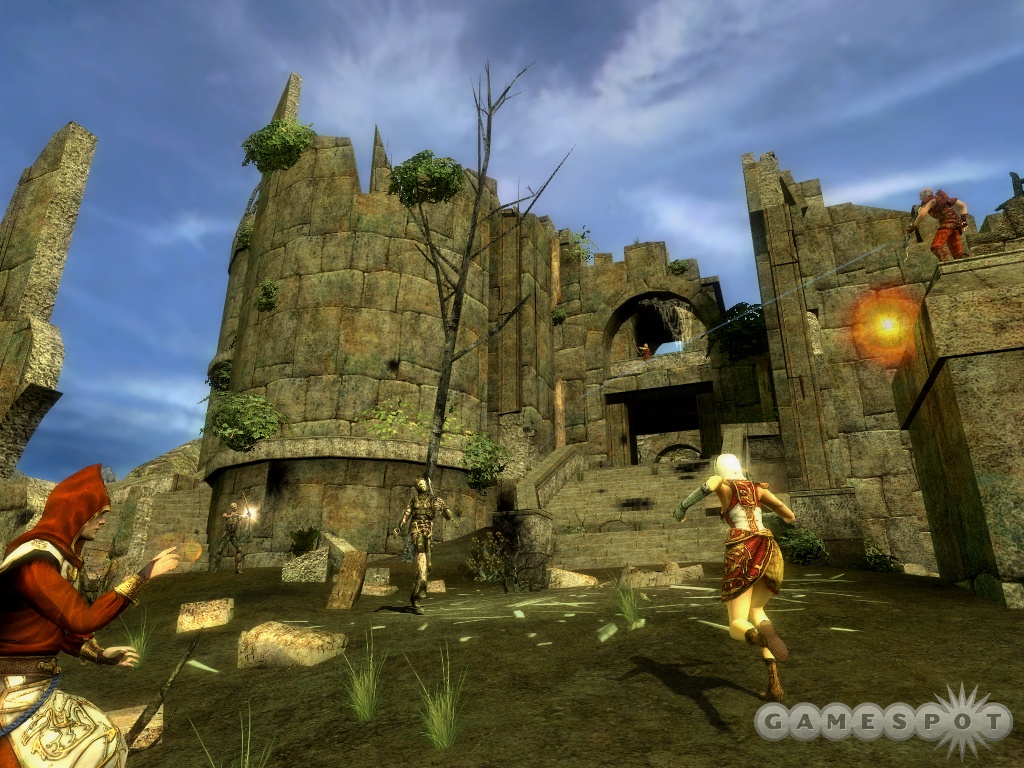Dark Messiah of Might and Magic Exclusive Multiplayer Hands-On
We go to Kuju Entertainment to get our hands on Dark Messiah's cool multiplayer campaign.
As we noted in our recent single-player preview, Dark Messiah of Might and Magic is essentially two very promising games in one. That's because Ubisoft has two separate teams at work on this fantasy-themed first-person action game. Arkane Studios in France is the lead team, since it began the project and is working on the single-player portion of the game. However, the developers at Arkane realized that they didn't have the time or the resources to dedicate to really fleshing out the multiplayer gameplay, so Ubisoft turned to England's Kuju Entertainment for that part of the game. We recently had a chance to visit Kuju's studio to be among the very first to get our hands on multiplayer, and we got to see all five levels of the interesting new crusade mode.
The multiplayer gameplay of Dark Messiah will feature the traditional deathmatch and team deathmatch that we've come to expect out of most games, and while a little mayhem can be a lot of fun, we were more interested in checking out crusade mode, which bears a bit of a resemblance to that of the popular Battlefield games. That's to be expected, since one of the key members of the Dark Messiah team is Romain de Waubert de Genlis, who was one of the creators of the Battlefield franchise. However, crusade isn't a Battlefield clone. As we discovered, it borrows some of the ideas of Battlefield, such as class-based warfare and capturing objectives, and adds continuity and role-playing elements to it.

The crusade mode is interesting because it links together five maps to form a campaign rather than featuring random battles on different maps, like in so many other games. Imagine five maps linked together to form a chain. At one end of the chain is Stonehelm, the human capital, while at the other end of the chain is Nar-Heresh, the undead capital. Two teams of up to 16 players each battle it out, with one team as the humans and the other as the undead. Crusade mode begins in Border Keep, the middle map in the chain, and whichever side wins that battle will push into the opposing team's territory. For the humans, that map is Vradek's Crossing, while for the Undead it's Nelsham's Scar. So if the undead wins the Border Keep battle, they push into Vradek's Crossing, and if the humans can't push them back in that fight, the battle advances to Stonehelm. If Stonehelm falls, then the undead win the campaign. This system lends the entire multiplayer affair meaning, as you're fighting for a larger goal than simply killing the enemy. It also allows a campaign to feature persistence. That's because as long as you're in a campaign, you'll gain experience along the way, which will allow you to unlock new abilities, such as being able to charge at enemies as a fighter. That rewards you for sticking with a campaign through the end, since you become more powerful as it goes on.
Of course, the deeper a team gets into an enemy's territory, the tougher it will be to win, thanks to the advantages of defense. Stonehelm is a city protected by high walls. In order to advance into the city, the undead must push a siege tower across an open field and against the city walls. Once there, the undead can then climb the siege tower to get atop the walls, essentially seizing the first objective point. From that point, the undead must battle through the city toward their ultimate objective, though this is a map that heavily favors the defenders most of the way. For instance, the humans can stand atop the wall and rain death on any undead units in the open as they attempt to push the siege tower forward. Defenders can also sally out of the gates (make sure someone is left behind to close and lock them) to engage the undead in the fields. If the undead can take the walls, the narrow streets and alleyways of the city still make the defender's job a bit easier, as they can create choke points to contain the undead.

For the humans to win, they must take the underground city of Nar-Heresh. Unlike Stonehelm, Nar-Heresh has no walls, but it does require any attackers to battle their way upward along narrow walkways, which makes it suitable for defenders. If the undead lose a control point it cannot be retaken, so defenders become more consolidated as they're pushed back. If pushed back to a final stand, the undead have the advantage of being able to control the main approaches to the human's final objectives. These are essentially giant, magically animated hands that serve as bridges, and a good undead tactic is to retract the bridge while the humans are charging across it. In order to cross, the humans will need to neutralize whoever is at the controls of the bridge.
We can easily imagine that crusade mode could turn into an epic back-and-forth match between two veteran teams, though like with Battlefield, it's safe to say that the experience will definitely depend on the quality of your team. Still, running as a mob during our play session proved to be quite an intense experience. Like in Battlefield, capture points help to focus the action around certain points on the map, so instead of having 32 players spread out evenly, you'll find most of them clustered around whichever capture points are in play. Now that you know the basics of crusade mode, we'll next cover the various classes in the game and how they can fit together to form a fighting unit.
Class Warfare
In the single-player game you get to play as Sareth, a sort of jack-of-all-trades who is good at swordfighting, backstabbing, archery, magic, and more. Though you don't get to play as Sareth in multiplayer, imagine that each of his skills were split off into a separate class and you have a good idea of the five character classes there are to play. The warrior is the frontline fighter, equipped with a sword and shield and whose role is to hack apart enemies in battle. However, he's limited only to melee combat, so his reach is limited. Then there's the assassin, a nimble scout who can turn mostly invisible and dispatch enemies with a vicious backstab with daggers. He's perfect for sneaking behind the front lines and taking out ranged units such as magic users and archers. The priestess is the healer of the group, and she can also resurrect fallen players, though there is a major drawback to this ability. Or, when you want to stand off and attack from a distance, the magic user can hurl spells while the archer can loose arrows at the enemy. Each of these classes is highly specialized, so while they're extremely good at one thing, they have definite weaknesses as well. This enforces the idea that they're complementary to one another, which means that to win the game you'll need a mix of all classes. 
It goes without saying that teamwork will be essential. In our battles, we found the odds of survival to be much higher when running in a pack, particularly a well-balanced one to deal with any eventuality. For instance, an enemy priestess found a particularly high perch in a contested temple and rained down poison curses upon our warriors. Without another priestess to cure us or an archer or mage to target the priestess, everyone was cut down repeatedly. Death itself isn't so much an issue, as the game uses a ticket system similar to that of Battlefield. When you die, a timer determines when you can spawn back in. While you're waiting, you can switch classes, as well as choose a different spawn point. So long as the team still has tickets left and have a control point, you can spawn back in. Another way to come back from death, though, is through the efforts of a priestess. She can resurrect fallen teammates, but the price is that everyone she resurrects is tied to her life force. If she dies, then it's like cutting the strings of a puppet--everyone the priestess resurrected immediately dies as well. That makes the priestess an incredibly high-value target, one worth protecting at all costs if the priestess is one of yours, or taking out if she's one of the enemy's. But wait, there's more. The priestess can also prevent an enemy priestess from resurrecting fallen enemies by devouring their souls. While she sounds like a powerful class, keep in mind that she's fairly vulnerable to damage and doesn't have great accuracy with her primary weapon, magical curses.
Your class in Dark Messiah will most likely depend on your play style. Fighters can be a lot of fun thanks to the intricacies of swordfighting. There's much more to it than just mashing the mouse button; you must time your swings, parry incoming attacks, and attack when you see an opening. If you're in a sword duel with another fighter, it can be a challenging fight to the death. If you're more of a dastardly backstabber, the assassin is perfect for sneaking and stabbing people for an instant kill. If you like playing support, or having a pack of warriors to protect you, the priestess is ideal. If you want to stand off from battle, use the mage, who was described to us as the "heavy artillery" of the game--though that also makes them ideal targets for the assassins. Then there are the archers, which can be thought of as snipers. It can be hard to hit a moving target with a bow and arrow thanks to the game's physics engine. Arrows droop in flight due to gravity, so you have compensate for range, but once you get the skill down through lots of practice you can be lethal.
To coordinate your team you can rely on a variety of communications systems. There won't be any built-in voice-chat capability in the game, though players will be able to communicate via the comprehensive message system. Team radio will let players issue commands to one another, while a team shout will let their characters scream a command in the game, though the danger is that nearby enemies will hear the command. Team gestures will allow for silent communication between teammates, while regular gestures will handle more conventional communication (such as bowing).

Not surprisingly, since Dark Messiah is built on Valve's Source engine, the visuals are on par with those of Counter-Strike Source and other Source-powered games. The action looks bright and colorful, thanks to high-dynamic range lighting and the rich color palette. Character models are nicely detailed and look good up close, particularly in a swordfight, and there are plenty of pretty magical effects in the air. The landscapes in the levels are all based on architectural elements in the single-player game, and the multiplayer itself serves as a prologue to the single-player portion of the game. Basically, the multiplayer tells the story of the war between humans and undead, while the single-player game picks up in the aftermath of the war.
In addition to crusade mode, Dark Messiah will ship with warfare mode, which is centered on stand-alone battles to seize or defend a castle. Kuju is also working on other modes that it hopes to ship with the game, and still others will be developed for release postlaunch. Regardless, the multiplayer that will ship with the game looks expansive, and the sword-and-sorcery action offers a refreshing change of pace from the flood of multiplayer shooters on the market. Dark Messiah is scheduled to ship in October. For now, find out how you can
Got a news tip or want to contact us directly? Email news@gamespot.com
Join the conversation